10 Years 10 Films (10Y10F) is a project to display embedded YouTube selections of cinema history. This is Part III of a series that gives the viewer a quick time-lapse view of how movie technology and style has developed throughout the world – one clip each year – from 1888 through 2017, starting with the foundations to see how filmmakers build upon or deconstruct them.
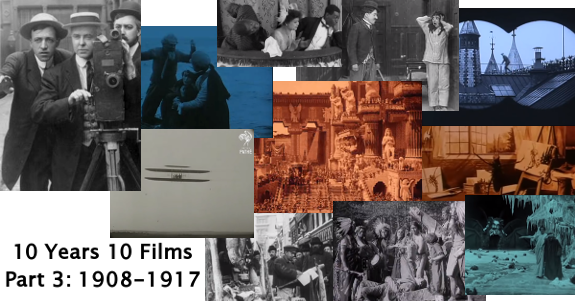
1908 to 1917 was a decade of major change in the film business. Here are a few highlights:
American cinema saw an expansion out of New Jersey and New York, into Jacksonville, Florida, for warmer weather; it then took hold in Hollywood, California, between 1909 and 1915. “One-reeler” films (1000ft in length, or about 10 to 12 minutes of runtime) gave way to feature-length epics, tinted with different colors to match the mood of each scene. Intertitles containing lines of dialogue began to be used consistently from 1908 onward. Studio cameras became more portable, and 35mm film was accepted as an industry standard.
The “star system” began in 1909, emphasizing actors over plot lines to promote films. African-American movie makers entered the market, as well as more women directors. Film-making also began to take hold in Russia, India, and Latin America. 1917 marks the beginning of the Classical Hollywood era with films characterized by a formulaic narrative and style, particularly through major film studios like Universal and Paramount.
In the following decade, we’ll finally enter into an era that some people alive today were around to see the film premieres.
Click on the Expand arrow for more details and additional films of note for that year. Disclaimers and the YouTube playlist of the 10 films highlighted here are at the end of this post.*
10Y10F Series:
I 1888-1897, II 1898-1907,
III 1908-1917, IV 1918-1927,
V 1928-1937, VI 1938-1947,
VII 1948-1957 …
/ Collapse All ˄
1908 – Wilbur Wright flying in France (British Pathé; France)
While not a film in the traditional sense, this newsreel shows possibly the first film clips of a Wright airplane. While they made their first flight in 1903, it wasn’t until 1908 that their invention was legitimized. Pathé showed these short news clips in theaters preceding the feature. Expand
Other film(s): A Fantasy (Fantasmagorie) (84sec. Paris, France.) Émile Cohl created this “chalk-line effect” story of a stick man encountering all sorts of morphing objects. It is considered the first fully animated film.
The Assassination of the Duke of Guise (La Mort du duc de Guise) (18min. André Calmettes & Charles Le Bargy. Paris, France. Alternate video with English subtitles, but poor sound sync.) Le Film d’Art company was created to make movies more palatable to the upper class. It has one of the earliest original scores, by world-renown composer Camille Saint-Saëns. Yet another example of the creativity of French filmmakers in 1908.
World events in 1908: Games of the IV Olympiad are held in London, including a winter session for the first time. William Jennings Bryan loses his third presidential election, to William Howard Taft. Butch Cassidy and the Sundance Kid allegedly killed in Bolivia. Ford’s Model T begins its first year of production, as well as the Irish ship Titanic. The MPPC trust of all the major American film companies standardizes production until 1915, when it is declared a monopoly. Births: American Actors Bette Davis and James Stewart, Portuguese director Manoel de Oliveira (d. 2015!), English director David Lean.
1909 – Moscow Clad in Snow (Mundwiller; Russia)
A documentary of Moscow contemporary life from the Kremlin and Marshal’s Bridge, the mushroom and fish market, and Petrovsky Park. Full review at Movies Silently. Expand
 8min. Joseph-Louis Mundwiller, French cinematographer. Film cleanup, commentary and music added by “Documentary History” YouTube channel.
8min. Joseph-Louis Mundwiller, French cinematographer. Film cleanup, commentary and music added by “Documentary History” YouTube channel.
Other film(s): Mark Twain at Stormfield (3min. Connecticut, USA.) Possibly the only moving picture of Mark Twain.
The Red Man’s View (14min. New York, USA.) An early collaboration, lasting through the silent film era, between director D.W. Griffith and cinematographer Billy Bitzer. This one includes film star Mary Pickford’s little sister, Lottie. The movie depicts – in a surprisingly sympathetic light for the time – the loss of American Indian homelands to white settlers.
World events in 1909: Leo Baekeland announces the creation of bakelite hard thermosetting plastic. Simultaneous expeditions to the North and South Poles with disputed results. The Anglo-Persian Oil Company, modern-day BP, is incorporated. The National Association for the Advacement of Colored People (NAACP) is founded. Author James Joyce manages The Volta Cinematograph, Ireland’s First Cinema. Births: Brazilian singer/actress Carmen Miranda. French director Marcel Carné. British actress Jessica Tandy.
1910 – White Fawn’s Devotion (Young Deer; USA)
When a white settler discovers he has inherited a fortune, his Native American wife attempts to kill herself, expecting that he will abandon her. Believing him to be a murderer, nearby Indians chase the settler before his wife is revived and everything is reconciled. Contrary to later Hollywood films, Native Americans were acting, writing, and directing during this time, as did James Young Deer in this one, whose ancestry was of the Nanticoke people of Delaware. Expand
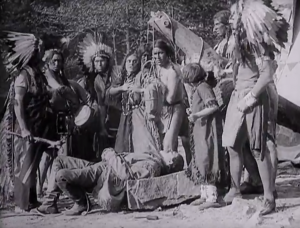 11min. James Young Deer. New Jersey, USA.
11min. James Young Deer. New Jersey, USA.
Other film(s): Slippery Jim (9min. Ferdinand Zecca. France.) A comedic tale of a pickpocket taken to jail, but he continually escapes by the magic of cinema. Likely inspired by Harry Houdini.
The Abyss (aka The Woman Always Pays aka Afgrunden. 37min. Denmark.) One of the first sex symbols in cinema, Asta Nielsen, makes her debut with husband/director Urban Gad in this tragic tale of a love triangle.
Frankenstein (12min. J. Searle Dawley. New Jersey, USA.) The first film adaptation of Mary Shelley’s monster horror classic, restored in 2017.
World events in 1910: The first public radio broadcast, an opera in New York. The first commercial zeppelin aircraft flight, in Germany. The Mexican Revolution begins. Births: American actors Nick Stewart and Joan Bennett, Japanese director Akira Kurosawa.
1911 – Dante’s Inferno (Bertolini et al; Italy)
Italy took France’s “film d’art” movement to new heights with this internationally-successful epic, depicting the classic tale of Dante in the circles of hell. It is the first Italian feature-length and the visuals are based on Gustave Doré’s woodcuts from The Devine Comedy. Expand
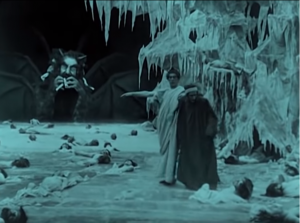 L’inferno. 72min. Francesco Bertolini, Adolfo Padovan, and Giuseppe de Liguoro.
L’inferno. 72min. Francesco Bertolini, Adolfo Padovan, and Giuseppe de Liguoro.
Other film(s): Banks of the Nile (6min. Charles Urban. London, England.) A documentary of Nile River life in Egypt, circa 1911. One of the first experiments of colorized films, utilizing Kinemacolor.
Tweedledum, Aviator (aka Robinet aviatore. 5min. Italy.) An early slapstick short from Spanish-born comedic actor-director, Marcel Perez. 12/23 UPDATE: Found better upload of the film, and corrected runtime from 10 to 5 minutes.
World events in 1911: The first Indianapolis 500 race is held. The Xinhai Revolution of China reaches its high point, leading to the 1912 fall of the Qing dynasty and establishment of the Republic of China. Ernest Rutherford identifies a large central mass in atoms. Births: American actor (and US President) Ronald Reagan, American entertainers Ginger Rogers and Lucille Ball, Irish actress Maureen O’Sullivan.
1912 – The Revenge of a Kinematograph Cameraman (Starevich; Russia)
An amazing puppet-animated work about infidelity and jealousy among the insects. Perhaps not coincidentally, released just a few years before Franz Kafka’s The Metamorphosis, also featuring bugs. Expand
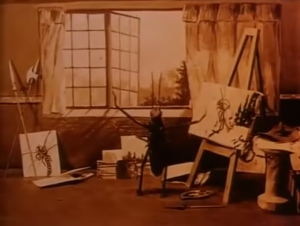 Mest kinematograficheskogo operatora. 13min. Ladislav Starevich (Polish: Władysław Starewicz). Moscow, Russia.
Mest kinematograficheskogo operatora. 13min. Ladislav Starevich (Polish: Władysław Starewicz). Moscow, Russia.
Other film(s): In Night and Ice (In Nacht und Eis. 34min. Mime Misu – born Mișu Rosescu in Romania. Berlin, Germany.) The first “feature” film about the sinking of the Titanic which happened earlier that year.
The Games of the V Olympiad Stockholm (Removed due to copyright claims. 170min. Joint venture Svensk-Amerikanska Film Kompaniet, Sweden.) The first Olympics to be extensively filmed. A 4K restoration and compilation of the films was completed in 2017. See also, these news clips from Pathé.
World events in 1912: Arizona and New Mexico become that last two states in the continental area. The RMS Titanic sinks on its maiden voyage. Births: Italian director Michelangelo Antonioni, American entertainer Gene Kelly.
1913 – Fantômas [trailer only] (Feuillade; France)
A crime film serial released in five parts, from 1913 to 1914. This was the first of Feuillade’s three hugely popular serials. He is credited with developing many of the thriller techniques used famously by Fritz Lang, Alfred Hitchcock, and others. Klaus Kreimeier has embedded all five episodes (French intertitles) on his website. Expand
 311min. Louis Feuillade. Paris, France.
311min. Louis Feuillade. Paris, France.
Other film(s): Suspense (10min. Lois Weber & Phillips Smalley. New York City, USA.) Weber was one of the first auteurs of cinema, writing, directing, and acting in hundreds of films. This one, true to its title, used multiple images and mirror shots to tell of a woman threatened by a burglar.
Raja Harishchandra (11min. Dadasaheb Phalke. India.) Only portions of the original 40-minute film exist, and some believe it may be from the 1917 version. Nonetheless, it is the first Marathi (and arguably Indian) feature film, about the legend of Harishchandra. Soumyadip Choudhury has written some good background on the film.
World events in 1913: The British Board of Film Censors (BBFC) is established. The Woolworth Building opens in New York City as the tallest building in the world; the redesigned Grand Central Terminal opens as the largest train station in the world. Stravinsky’s new Rite of Spring ballet provokes riots at its Paris premiere. Carl Jung and Sigmund Freud meet for the last time at the IPA in Munich. Births: American actor Lloyd Bridges, English actors Vivien Leigh and Peter Cushing.
1914 – Mabel’s Strange Predicament (Normand; USA)
In a hotel lobby, a heavily drunk tramp runs into an elegant lady, Mabel, and harasses her dog. He later runs into her in the hotel corridor, locked out of her room. They run through various rooms, eventually being attacked by a jealous wife. This is Charlie Chaplin’s first recording as the Tramp. Mabel Normand was already a star and helped Chaplin transition into film acting with her writing/directing/producing prowess. Expand
Other film(s): Gertie the Dinosaur (9min. New York, USA.) Winsor McCay was a key player in the development of animation. Half of this piece is a live-action setup where McCay bets several gentlemen that he can animate a dinosaur, and then we see the process which requires thousands of pieces of paper. In the second half of the film, he shows the men the animation of the dinosaur responding to his commands.
The Hazards of Helen (Episode 13: The Escape on the Fast Freight. 13min. J.P. McGowan. Hollywood, USA.) The mid-1910s brought a flurry of women-adventure serials – and they did some serious stunt work! The longest-running one (119 episodes from 1914-1917) featured Helen Holmes as a railroad telegrapher.
World events in 1914: Austrian Archduke Franz Ferdinand assassinated in Bosnia, marking the start of “The Great War” (or World War I). The Panama Canal opens. Camel introduces the first packaged cigarette. English actor Cary Grant born.
1915 – Two Knights of Vaudeville (Ebony Film; USA)
“When a well-to-do man drops his theater tickets, they are retrieved by a trio from the wrong side of the tracks. Once admitted into the swanky theater, the trio causes chaos and has an uproarious time. This picture was released by the controversial Ebony Film Corporation and was partially responsible for its downfall.” – Fritzi Kramer, review on Movies Silently. Side note: check out the Kino Pioneers of African-American Cinema set, also streaming on Netflix. Expand
Other film(s): The Cheat (59min. Hollywood, USA.) An early Paramount Pictures film that caused controversy due to its portrayal of a lead Japanese character as sinister – see Yellow Peril in history. Sessue Hayakawa, the actor, was one of the few Asian sex symbols in Hollywood. The director, Cecil B. DeMille, went on to become the most financially successful film director in history, notable at this time for his dramatic lighting techniques.
World events in 1915: Alexander Graham Bell makes the first long distance phone call, from New York to San Francisco; the process took 23 minutes to patch in. Germans begin wide-scale use of tear gas as chemical weapons of war. Pluto is photographed for the first time. Babe Ruth hits his first career home run. Franz Kafka’s The Metamorphosis is published in Germany. Inspired by the release of The Birth of a Nation, William J. Simmons revives the KKK in Georgia. The first stop sign appears in Detroit. Births: American filmmaker Orson Welles, Swedish actress Ingrid Bergman.
1916 – Intolerance (Griffith; USA)
Like the other films mentioned above from 1915, D.W. Griffith produced arguably the most racist – and most influential epics in history. In my opinion, his next film was even more ambitious, thoughtful, and technically outstanding. Intolerance consists of four distinct, but parallel, stories—intercut with increasing frequency as the film builds to a climax—that demonstrate humankind’s persistent intolerance throughout the ages. The timeline covers approximately 2,500 years. Expand
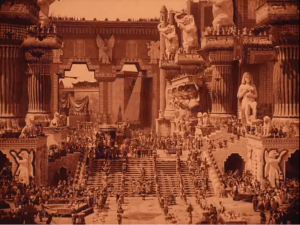 Subtitles include: Love’s Struggle Throughout the Ages and A Sun-Play of the Ages. 166min. Hollywood, USA.
Subtitles include: Love’s Struggle Throughout the Ages and A Sun-Play of the Ages. 166min. Hollywood, USA.
Other film(s): The Mystery of the Leaping Fish (25min. John Emerson. Hollywood, USA.) In this unusually broad comedy for Douglas Fairbanks early in his film acting career, the acrobatic leading man plays “Coke Ennyday”, a cocaine-shooting detective who is a parody of Sherlock Holmes. Incidentally, Fairbanks makes a small appearance in Intolerance, as well.
The Battle of the Somme (73min. Geoffrey Malins. Thiepval, France. A.k.a. Kitchener’s Great Army in the Battle of the Somme.) British documentary and propaganda film showing some of the only real – and some staged – footage of World War One.
A Natural Born Gambler (23min. New York, USA.) The first film to be written, directed, and acted by an African-American. Bert Williams was a famous Vaudeville and Ziegfeld Follies comedian, and this film is a showpiece for his unique style, despite the tragic nature of the storyline.
World events in 1916: The Saturday Evening Post begins to publish Norman Rockwell paintings for its covers. Canadian Dr. Bruce Robertson publishes blood transfusion paper, outlining his successes with soldiers on the Western Front. BMW is founded, first producing aircraft engines, then motorcycles and automobiles years later. Five shark attacks on the New Jersey shoreline, later inspires the writing of Jaws. The Battle of the Somme in Northern France results in over 1 million deaths. Berlin Summer Olympics cancelled due to WWI. Births: American filmmaker Kirk Douglas and English-American actress Olivia de Havilland (both currently 101 years old!).
1917 – A Man There Was (Sjöström; Sweden)
Terje, a sailor, suffers the loss of his family through the cruelty of another man during the Napoleonic Wars. Years later, when his enemy’s family finds itself dependent on Terje’s beneficence, Terje must decide whether to avenge himself. Terje Vigen (Swedish title of the film) was a popular poem set and written in the 1800s, by Norwegian Henrik Ibsen. This early film by Victor Sjöström (a.k.a. Seastrom) kicks off the “Golden Age” of Swedish cinema. Sjöström became most known for directing The Phantom Carriage (Körkarlen) and later as an actor in Bergman’s Wild Strawberries (1957). Expand
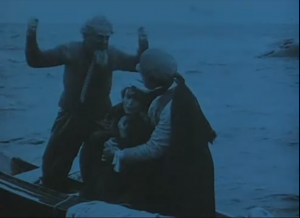 55min. Found in 2004 after being lost for many years, the film has been documented anywhere from 44 to 72 minutes long.
55min. Found in 2004 after being lost for many years, the film has been documented anywhere from 44 to 72 minutes long.
Other film(s): Coney Island (Roscoe ‘Fatty’ Arbuckle. 25min. New York, USA.) An energetic and comical romp through the famous Brooklyn amusement park. Arbuckle, Alice Lake, and Buster Keaton were early stars of Paramount Studios and this is one of their best from that era.
The Poor Little Rich Girl (77min. Maurice Tournier. New Jersey, USA.)
The wealthy but selfish parents of a lonely young girl begin to rethink what is important to them after a servant’s irresponsibility results in a crisis. Mary Pickford was one of the first stars of cinema and this is a great example of her on-screen charisma. (The YouTube video linked here is HD 720p.)
World events in 1917: Women’s suffragists begin picketing the White House in January, until the passing of the Nineteenth Amendment in June. The US ends its nine-month search for Pancho Villa in the Border War with Mexico as they declare war on Germany and Austria-Hungary. Tsar Nicholas II abdicates his throne, ending the Russian Empire. Births: American actors Lina Horne and Dean Martin, Hungarian-American actress Zsa Zsa Gabor.
* DISCLAIMERS
“Silent” film screenings were usually accompanied by live music, narration, and/or sound effects – improvised, compiled from cue sheets of common themes, or more commonly in the 1910s original score. These details can be tough to track down so it’s hard to tell if the sound accompanying most of the clips in this post were intended by the original director.
Precise details on the films are hard to come by, even in the history books, much less the repeated misinformation on the internet. I’ve also discovered that the number of IMDb votes that a film has from this era is not necessarily an indication of its popularity, particularly if the film is in a “lost” status; rather, the votes indicate what is popular today.
I will attempt to keep these videos up to date as YouTube videos tend to disappear from time to time. Most of the screenshots that I’ve posted are from the original videos when this was created in December 2018. I’ve captured a copy of the original page on Archive.org for comparison.
Other than a couple of classes in college involving film, I fully admit to having no professional training in cinema history. Please let me know if any corrections need to be made, or if you have any other feedback. I usually respond pretty quickly to comments on this site.
YouTube playlist: 10Y10F Part 3: 1908-1917
10Y10F Series:
I 1888-1897, II 1898-1907,
III 1908-1917, IV 1918-1927,
V 1928-1937, VI 1938-1947,
VII 1948-1957 …
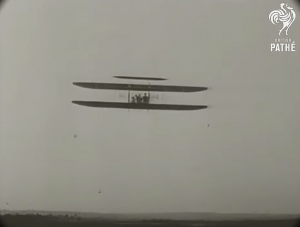

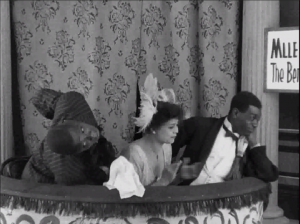
Comments
7 responses to “Video clips and history of world cinema: 1908-1917”
[…] http://zepfanman.com/2018/12/videos-world-cinema-1908-1917-10y10f3/^titles from the list:1908 – Wilbur Wright flying in France (British Pathé; France)1909 – Moscow Clad in Snow (Mundwiller; Russia)1910 – White Fawn’s Devotion (Young Deer; USA) […]
[…] http://zepfanman.com/2018/12/videos-world-cinema-1908-1917-10y10f3/^titles from the list:1912 – The Revenge of a Kinematograph Cameraman (Starevich; Russia)1913 – Fantômas [trailer only] (Feuillade; France)1914 – Mabel’s Strange Predicament (Normand; USA)1915 – Two Knights of Vaudeville (Ebony Film; USA) […]
[…] Series: I 1888-1897, II 1898-1907, III 1908-1917, IV 1918-1928 […]
[…] Series: I 1888-1897, II 1898-1907, III 1908-1917, IV 1918-1927, V 1928-1937 […]
[…] Series: I 1888-1897, II 1898-1907, III 1908-1917, IV 1918-1927, V […]
[…] Series: I 1888-1897, II 1898-1907, III 1908-1917, IV 1918-1927, V […]
[…] Series: I 1888-1897, II 1898-1907, III 1908-1917, IV 1918-1927, V 1928-1937, VI 1938-1947 […]